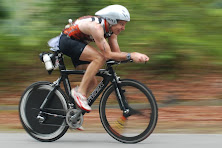First ride: Trek Speed Concept
By: Matt Pacocha, Bikeradar.com
Trek's Speed Concept 9.9 model.
Cyclingnews races Trek's new time trial machine
 Trek’s Speed Concept is one darn fast ride. In fact, it’s the fastest aero bike we’ve ever ridden, and it shaved over a minute off our previous personal best at our local weekday time trial series.
Trek’s Speed Concept is one darn fast ride. In fact, it’s the fastest aero bike we’ve ever ridden, and it shaved over a minute off our previous personal best at our local weekday time trial series.Admittedly it’s the first of the new generation time trial bikes – including the Cervélo P4, Giant Trinity Advanced SL and Scott Plasma 3 – that we’ve slung a leg over, but we've put plenty of time in on the older Cervelo P3 and Giant Trinity Alliance.
 Despite being built with the triathlon market in mind, the Speed Concept made its debut in the time trials at last year's Tour de France, so we figured the best way to test this bike was to go out and race it.
Despite being built with the triathlon market in mind, the Speed Concept made its debut in the time trials at last year's Tour de France, so we figured the best way to test this bike was to go out and race it.The fact that we set our fastest time in an event we’ve been racing for four years during our second ride on it is a testament to the bike's high performance. The 10.4-mile course is rolling and features three significant climbs that can be ridden in the big ring. Our fastest time in 2009 was 25:30, and our fastest ever time came in 2008 at 24:19.
We posted a 23:17 on the Speed Concept 9.9 this week. While this comparison is completely unscientific and the results are influenced by wildly different wind and weather conditions, equipment variables (we did use the same wheels as previously – a set of Zipp 999s), not to mention the test rider’s fitness, we have to attribute at least a portion of our saved time to Trek’s engineering team.
What is undisputable is that we’ve ridden this same race in horribly slow conditions as well as on extremely fast nights with the wind at out back and never gone this quickly.
[Simon says: - Interestingly their 1min02sec PB over a 16.6km course is almost exactly the advantage that Trek claim to have over their nearest rival (Cervelo) if you project it over an Ironman i.e. 10 minutes - coincidence?]
 The test bike
The test bikeOur Speed Concept 9.9 retails for US$8,924.99 (somewhere between £7500-8000 at UK prices) and is painted with the team colours and plastered with the sponsor logos of Trek’s Ironman superstar Chris Lieto.
It's admittedly a tri version, equipped with a UCI illegal base bar and seat post that exceeds the 3:1 ratio for airfoils. However, we didn't use the (also UCI illegal) detachable DraftBox on the back, and the rest of the kit is completely UCI legal. We also ran our saddle setback within the UCI’s limits.
 (Two small lengths of shifter cable run from the extensions to the base bar.)
(Two small lengths of shifter cable run from the extensions to the base bar.)Our test bike comes equipped with a SRAM Red drivetrain, complete with R2C ‘aero’ shifters. Gearing pairs a standard 53/39 crank to an 11-23T PowerDome cassette. The base bar, extensions and seatpost are all from in-house brand Bontrager.
Trek take care of braking duties with their proprietary Speed Concept integrated centre-pull brakes and Bontrager carbon brake levers. The proprietary brakes offer plenty of power and modulation; the only disadvantage we can find is their somewhat complicated setup.
We tested the Speed Concept with a ‘control’ wheelset – one we’ve ridden on our test course many times – Zipp’s 999 disc wheelset, which pairs a 900 disc with an 808 front wheel. Ours are clinchers for convenience.
 The ride
The rideIn addition to improving the aerodynamic properties of the Speed Concept, Trek also modified geometry for better handling. A slightly lower bottom bracket and mellower head tube angle make for a more stable ride, which is noticeable in crosswinds, but the modifications don’t hamper the bike’s prologue prowess.
While our Speed Concept still rides like a time trial bike, we wouldn’t doubt its abilities on a technical course due to the pedestrian dodging we’ve done on ours through Boulder’s packed multi-use bike paths.
 (The rear seat tube and seat stays sport the Kamm Tail shape; the last loop to the derailleur is one of the only cables that shows on this bike.)
(The rear seat tube and seat stays sport the Kamm Tail shape; the last loop to the derailleur is one of the only cables that shows on this bike.)Criticism?
We found the front end to be somewhat soft, especially considering the small stature of our test rider. The frame and fork seem solid, but when standing and putting maximum effort into a climb or sprint, things start noodling around.
The impression is that the flex is coming from the bars and their connection to the fork, specifically through the back/top of the steerer – a price of the extreme aerodynamic properties of the stem, perhaps. This will not affect the performance for triathletes; however, we have to imagine the RadioShack guys will know what we’re talking about.
Pedalling stiffness is good, but the bike’s rear end isn't mindblowing when it comes to stiffness, as we could still make it move. The cockpit is compact, which is also only an issue when standing.
 We had to consciously centre ourselves when standing to keep our knees knocking the bar or our backside getting poked by the saddle. Some of this can be attributed to the girth of the non-conforming base bar. It may also have something to do with how Trek fit the new bikes through stack and reach instead of a certain frame dimension; the base bar remains in a fixed position no matter the fit.
We had to consciously centre ourselves when standing to keep our knees knocking the bar or our backside getting poked by the saddle. Some of this can be attributed to the girth of the non-conforming base bar. It may also have something to do with how Trek fit the new bikes through stack and reach instead of a certain frame dimension; the base bar remains in a fixed position no matter the fit.We weren’t entirely happy with the base bar’s shape, either. It seemed to put the bullhorns a bit too far forward for our size; we'd have preferred a version without the forward sweep. As for the 9.9 specification, the only nit we can pick is with the magnesium railed Fizik Arione Tri2 saddle. We’d expect a titanium K:ium railed version on a bike that costs close to $9,000.
Is this the fastest bike available? Ever?
Trek tell a compelling story with the Kamm tail virtual airfoil – see our first look at the Speed Concept for more on this – and such bold claims can often be written off as marketing hype. However, while it's difficult to judge without wind tunnel tests, things seem different with this bike.
The Kamm tail concept was originally developed in the the auto industry, and unlike time trial bikes, most cars aren’t sold based on their advertised aerodynamic advantages. When someone buys a Toyota Prius they don't do so because of its Kamm tail body shape, but because of its 50mpg fuel economy – an attribute that aerodynamics obviously play a part in.
While we were given the opportunity to test the top (non-Project One) Speed Concept model, we have to commend Trek for trickling the Kamm tail technology down to all of their price points, right out of the gate.
The entry-level 9 Series model (made in Wisconsin from Trek’s OCLV Red Carbon) comes in at $5,774.99 with a spec that’s still fully capable for professional level time trialling, while the 7 Series (made from Trek’s TCT carbon in Asia) bikes start at $2,519.99, and an aluminium model rounds out the line for under $2k, yet still sports the Kamm tail features in its down tube, seat tube and fork legs.
Bottom line
The Speed Concept must be a consideration for those in the market for an aero bike, especially considering that Trek offer the Kamm tail technology at a wide range of price points. The only thing missing right now is the option to buy the Speed Concept as a frameset. Trek say 'fuselages' (frame, fork, stem, bar, brakes) will be available by late summer. INTERESTING!!!!!


2 comments:
The speed concept appears to be a bike any triathlete would consider. Having top of the line components and wheels on my current TT bike, as long as the frameset is not available,there will be no Speed Concept for me. Sorry Trek...
Hey Triguy, fanatastic news in that case. The Speed Concept has been available in frameset for about 9 months now. I believe the price is USD4,499. I eventually went with a Project One Cool Fire with Di2's. See later posts for the piccies.
Hope you get one, you'll NEVER regret it.
Post a Comment